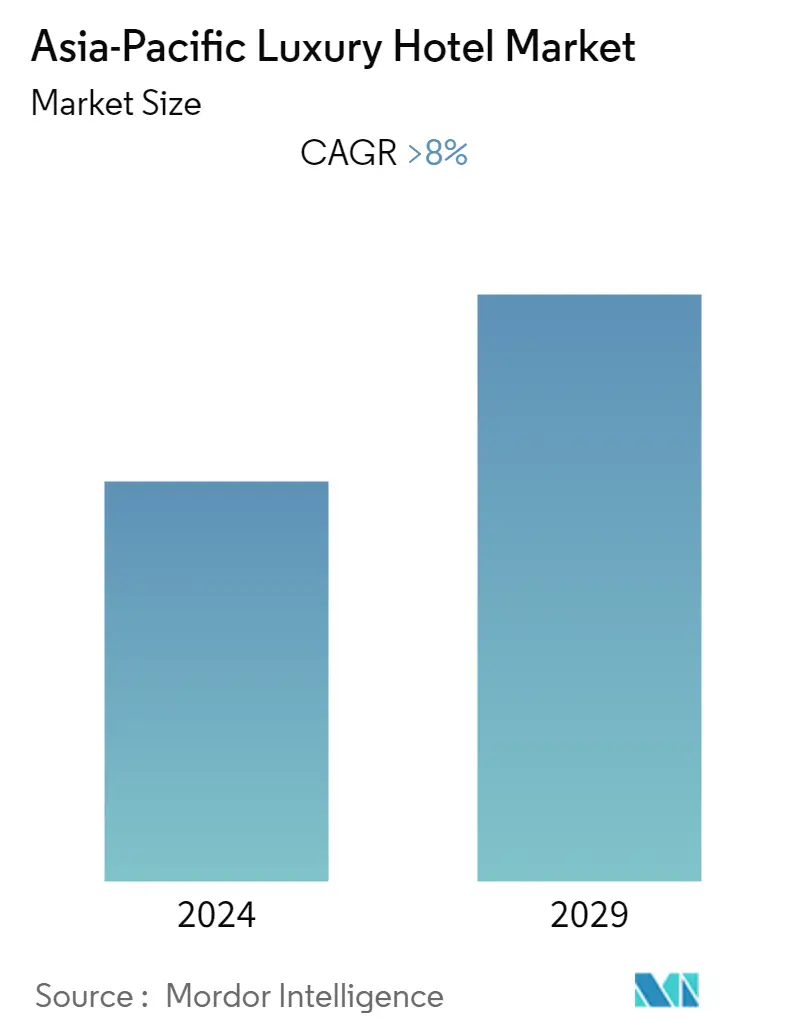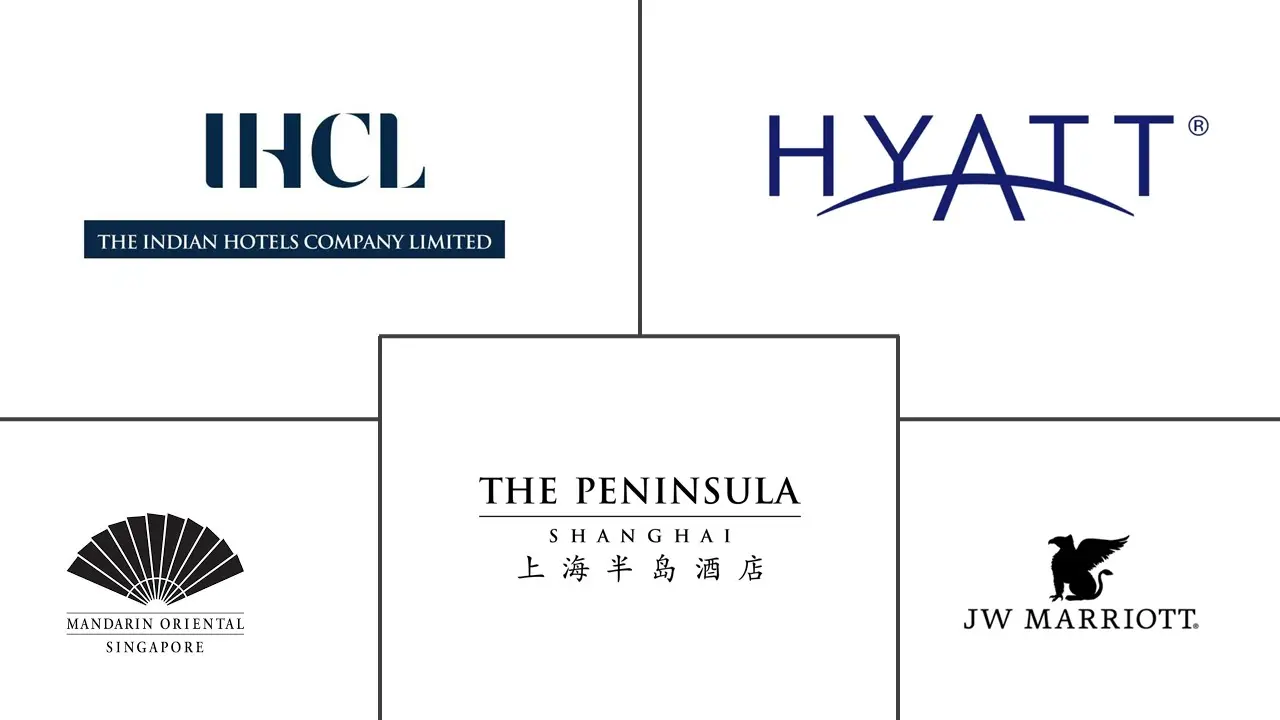Market Size of Asia-Pacific Luxury Hotel Industry

| Study Period | 2020 - 2029 |
| Base Year For Estimation | 2023 |
| Forecast Data Period | 2024 - 2029 |
| Historical Data Period | 2020 - 2022 |
| CAGR | > 8.00 % |
| Market Concentration | Medium |
Major Players
*Disclaimer: Major Players sorted in no particular order |
Need a report that reflects how COVID-19 has impacted this market and its growth?
APAC Luxury Hotels Market Analysis
The Asia-Pacific Hotel Market has generated revenue of USD 18.4 billion in the current year and is poised to achieve a CAGR of 8% for the forecast period.
Luxury hotels differ from traditional hotels as they provide advanced services at a higher price. Even though the core function of all hotels and accommodation units is the same and requires hotel employees to provide the best of their services, luxury hotels are able to provide an even more enriched customer experience to their clients because they deal with large investments and revenue. Because luxury hotels invest heavily in the seamless integration of technology and services, it serves as a positive reinforcement for future global luxury hotel market growth.
The effect of COVID-19 on the hospitality industry can be observed in all regions including Asia-Pacific. The Covid-19 pandemic caused the Asia-Pacific market size to suffer losses due to the closure of restaurants, hotels, and accommodation services in 2020. The hotel industry was the first and most affected sector across economies because almost all regions were under lockdown and people's movement was heavily regulated. Even though hotels are permitted to operate as before, the industry as a whole is expected to take a few more years to recover from the losses experienced in the previous two years.
However post Covid-19, the market is expected to observe growth due to the increasing outbound travel by the young population within the region as well as growing inbound travel to the region. Rising disposable income, an increase in people's standard of life, expanding business and tourism industries across the region, and an increase in people's desire for leisure travel are all predicted to propel the industry. Some of the essential elements that draw guests to luxury resorts are the inflation of spending power and living standards. The growing government focus on the tourism industry in the region is a major driver for the industry.
Large international brands lead the hotel market's growth in APAC, but smaller chains and local developers also create interesting offerings for their guests. The largest project set to open in the APAC region is the Mui Dinh Eco-Resort in Vietnam. The development will include 7,000 rooms and 500 ocean-facing villas as well as amenities like a theme park, a casino, a beach club and a mountain clubhouse. Marriott International, Inc. is expecting to open 14 additional luxury properties in Asia Pacific by the end of 2023.
APAC Luxury Hotels Industry Segmentation
A luxury hotel is defined as a hotel that provides a luxurious accommodation experience to the guest. Luxury hotels typically accommodate high-paying guests and the services and dining are expected to be of high quality. A complete background analysis of the North America Luxury Hotel Market, which includes an assessment of the emerging trends by segments and regional markets, significant changes in market dynamics, and a market overview, is covered in the report.
The Asia-Pacific Luxury Hotel Market is Segmented by Service Type (Business Hotel, Airport Hotel, Suite Hotel, Resort, and Other Service Hotels) and by Geography (China, India, Japan, Australia, Thailand, Vietnam, Rest of Asia-Pacific). The report offers market size and forecasts for the Asia-Pacific Luxury Hotel Market in terms of value (USD billion) for all the above segments.
| Product Type | |
| Business Hotel | |
| Airport Hotel | |
| Holiday Hotes | |
| Resorts & Spa |
| Geography | |
| China | |
| India | |
| Japan | |
| Australia | |
| Thailand | |
| Vietnam | |
| Rest of Asia-Pacific |
Asia-Pacific Luxury Hotel Market Size Summary
The Asia-Pacific Hotel Market, particularly the luxury sector, is experiencing significant growth. Luxury hotels, which provide advanced services at a higher price, have been investing heavily in technology and services, positively impacting market growth. The Covid-19 pandemic did cause significant disruption to the industry, with closures of hotels and accommodations causing substantial losses. However, the industry is expected to recover in the coming years, driven by increasing outbound and inbound travel in the region, rising disposable income, improved living standards, and expanding business and tourism industries. The growing government focus on the tourism industry in the region is a major driver for the industry. Large international brands lead the hotel market's growth in APAC, with smaller chains and local developers also contributing. There are several significant projects in the pipeline, including the Mui Dinh Eco-Resort in Vietnam and numerous properties by Marriott International, Inc. The rising population preferring leisure vacations and an increase in the number of hotel projects are key trends driving the market. Globalization has led to increased travel, benefiting the luxury hotel industry. The industry is also boosted by the rising number of business trips, with professionals typically housed in upscale hotels. Key players in the Asia-Pacific Luxury Hotel Market include Penninsula Shangai, The Indian Hotels Company Limited, JW Marriott, Hyatt Group, and Mandarin Oriental Hotel Group.
Explore MoreAsia-Pacific Luxury Hotel Market Size - Table of Contents
-
1. MARKET DYNAMICS AND INSIGHTS
-
1.1 Market Overview
-
1.2 Market Drivers
-
1.3 Market Restraints
-
1.4 Value Chain Analysis
-
1.5 Industry Attractiveness: Porter's Five Forces Analysis
-
1.5.1 Threat of New Entrants
-
1.5.2 Bargaining Power of Buyers
-
1.5.3 Bargaining Power of Suppliers
-
1.5.4 Threat of Substitutes
-
1.5.5 Intensity of Competitive Rivalry
-
-
1.6 Insights into Technological Advancements in the Industry
-
1.7 Insights on Current Trends and Recent Developments in the Market
-
1.8 Impact of COVID-19 on the Market
-
-
2. MARKET SEGMENTATION
-
2.1 Product Type
-
2.1.1 Business Hotel
-
2.1.2 Airport Hotel
-
2.1.3 Holiday Hotes
-
2.1.4 Resorts & Spa
-
-
2.2 Geography
-
2.2.1 China
-
2.2.2 India
-
2.2.3 Japan
-
2.2.4 Australia
-
2.2.5 Thailand
-
2.2.6 Vietnam
-
2.2.7 Rest of Asia-Pacific
-
-
Asia-Pacific Luxury Hotel Market Size FAQs
What is the current Asia-Pacific Luxury Hotel Market size?
The Asia-Pacific Luxury Hotel Market is projected to register a CAGR of greater than 8% during the forecast period (2024-2029)
Who are the key players in Asia-Pacific Luxury Hotel Market?
Penninsula Shangai, The Indian Hotels Company Limited, JW Marriott, Hyatt Group and Mandarin Oriental Hotel Group are the major companies operating in the Asia-Pacific Luxury Hotel Market.
